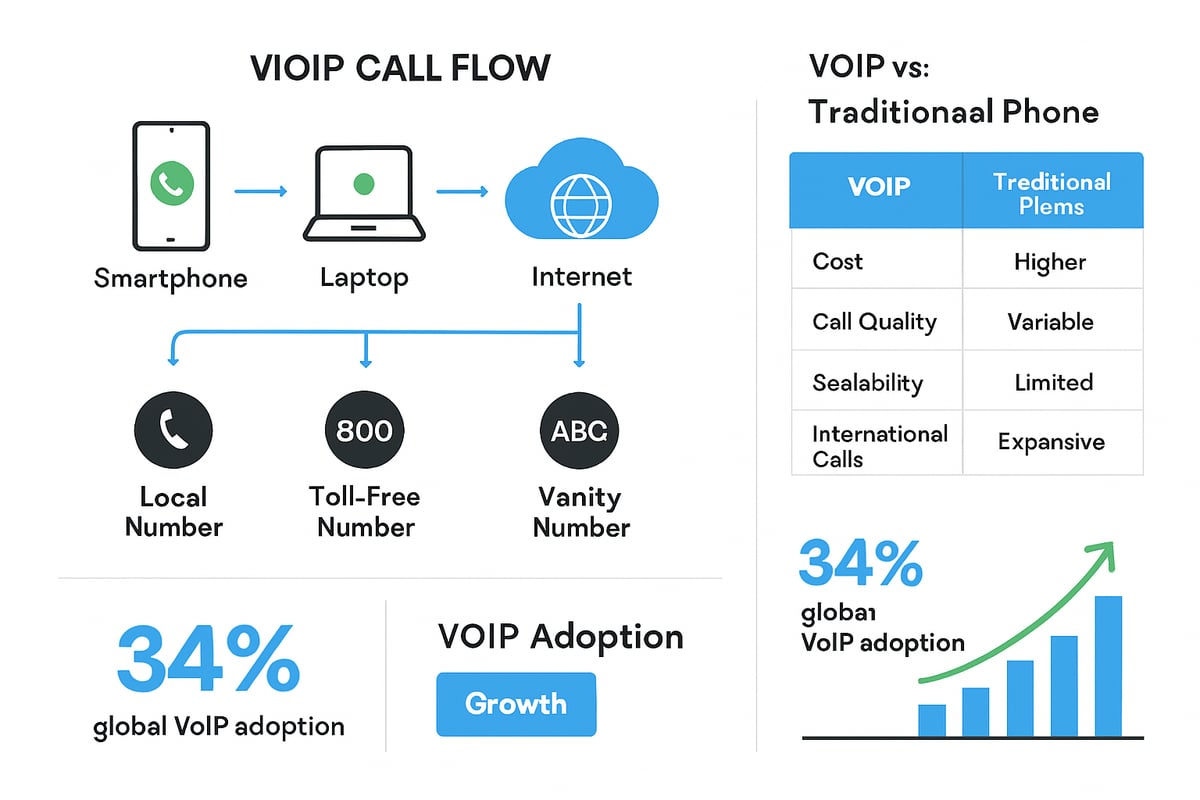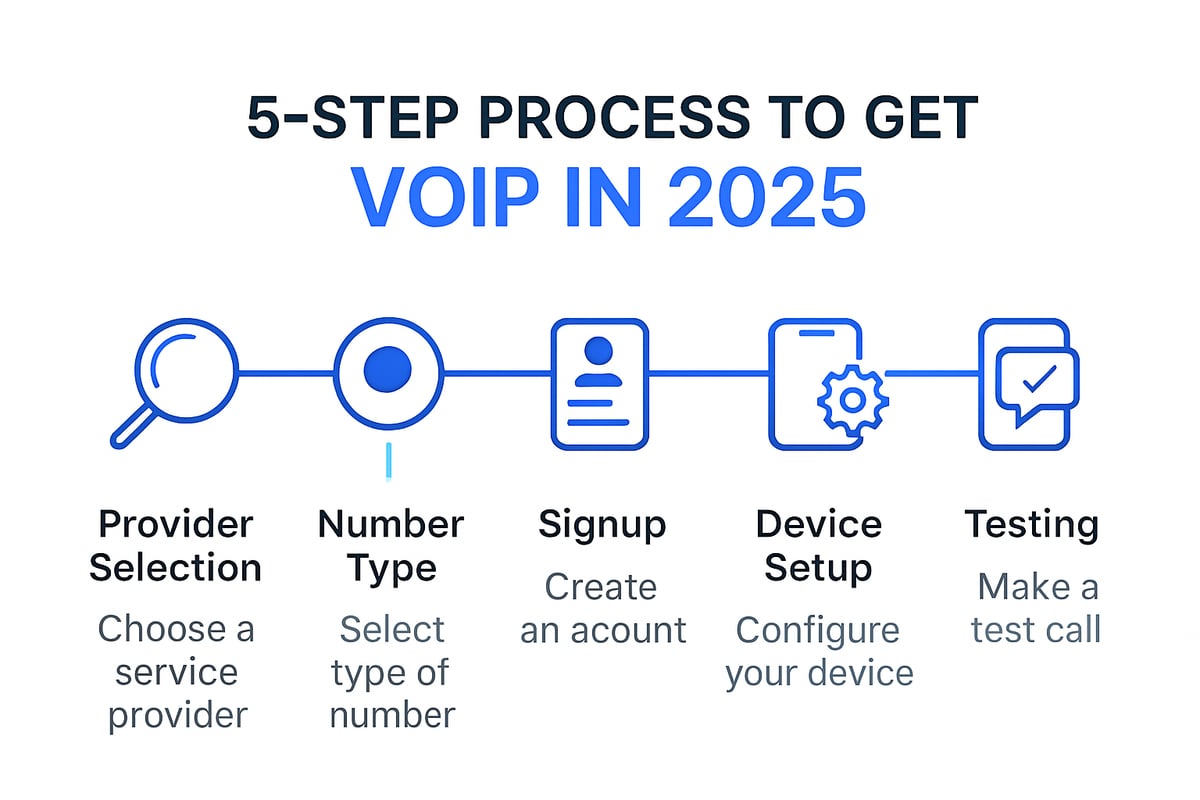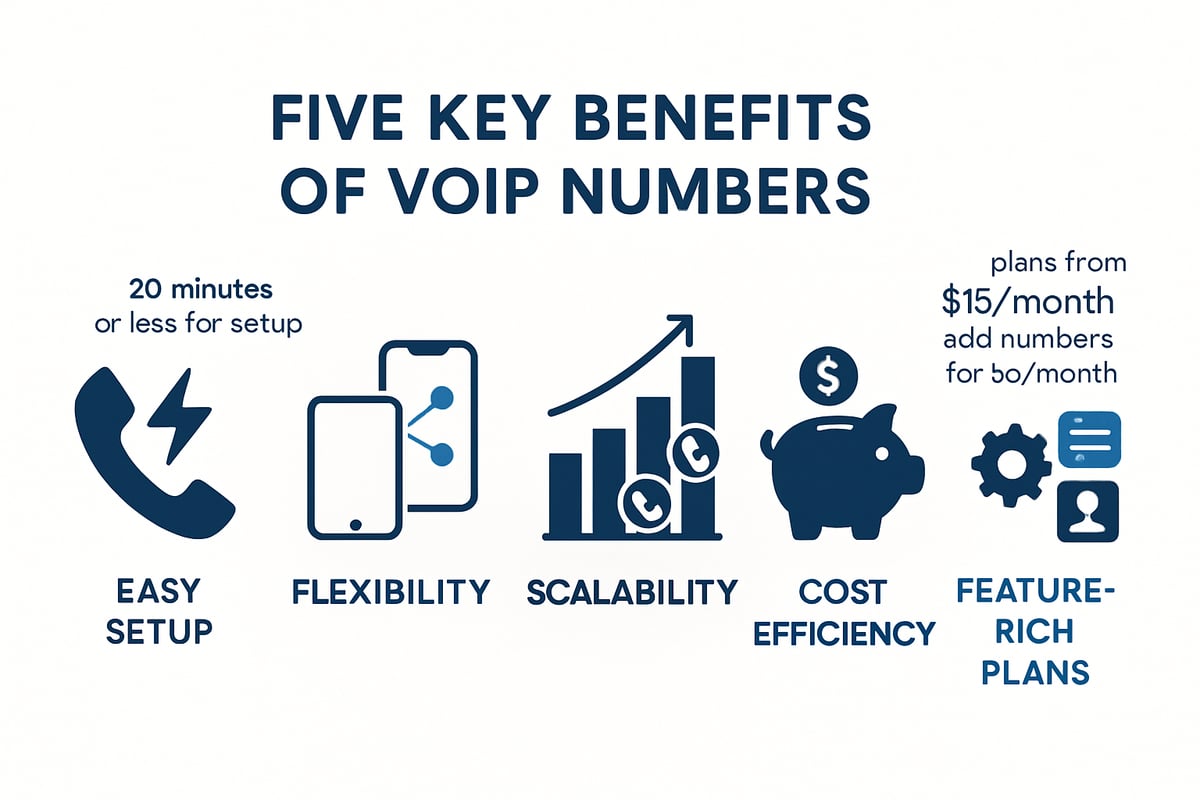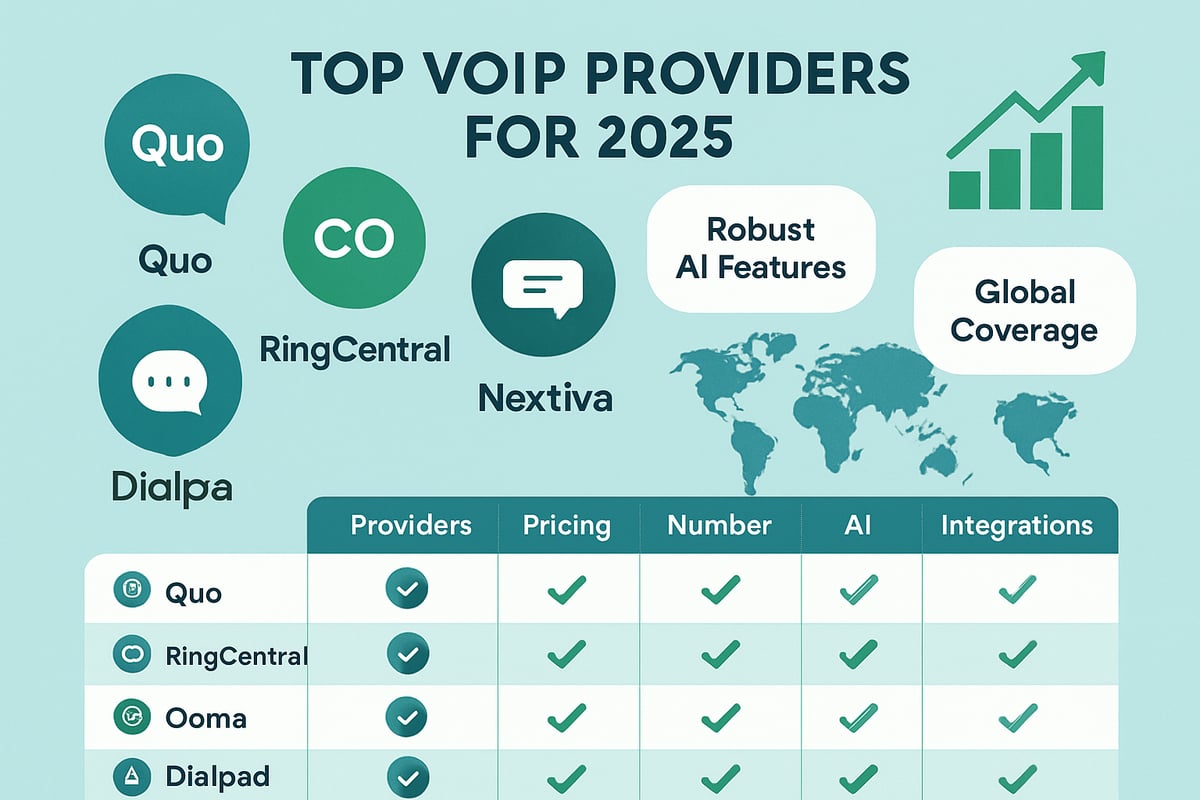Get VoIP Guide: Everything You Need to Know in 2025
Get VoIP in 2025 with this expert guide covering setup, benefits, provider comparisons, features, and security to help you choose the best VoIP solution.
Redaction
08/10/2025, 12:30:00In 2025, communication is rapidly evolving as more people and businesses move away from traditional phone lines. Are you ready to get voip and embrace the future of calling?
This guide will help you understand what VoIP is, how it works, and why it is essential for modern communications. You will discover step-by-step instructions, key benefits, and expert tips to make the most of VoIP technology.
We will cover everything from choosing the right provider to security considerations and frequently asked questions. Stay ahead as the world transitions to flexible, scalable, and affordable communication solutions.
Ready to transform how you connect? Let’s get started.
Understanding VoIP: What It Is and How It Works
In today's digital landscape, understanding how to get voip is essential for anyone seeking flexible, modern communications. Voice over Internet Protocol (VoIP) lets you make calls using the internet instead of traditional phone lines. Unlike standard landlines or mobile numbers, VoIP numbers are digital, offering more versatility for both businesses and individuals. For example, making a call via a business VoIP app uses your data connection, not copper wires. Over 31% of businesses worldwide now rely on VoIP as their main communication method, showing its foundational role in today's world. For a complete overview, see VoIP phone service explained.

What Is VoIP?
VoIP works by converting your voice into digital data, which is then transmitted over the internet to the recipient. When you get voip, your calls are routed online instead of through physical phone lines. Devices like computers, smartphones, or VoIP adapters can connect you instantly, with no need for SIM cards or dedicated lines. Popular apps such as WhatsApp, Telegram, and business VoIP platforms all use this technology. The quality of your experience depends on a stable internet connection, making reliable broadband a must for clear calls.
Types of VoIP Numbers
When you get voip, you can select from several types of numbers to suit your needs:
- Local numbers: Establish a presence in specific regions, ideal for US, Canada, and international markets.
- Toll-free numbers: Use area codes like 800 or 888 to make it easy for customers to reach you.
- Vanity numbers: Choose memorable, branded options, for example, 1 800 FLOWERS.
- International numbers: Expand your reach globally by serving clients in multiple countries.
Many businesses use local numbers to connect with remote markets, while others choose vanity numbers for branding. This flexibility allows organizations to align their communication channels with business goals.
VoIP vs. Traditional Phone Services
Comparing get voip to traditional services highlights major advantages in cost, features, and scalability. VoIP plans typically start at $15 per user per month, while the average traditional cell bill is $141. You can add new numbers for departments within minutes, supporting rapid growth and operational changes. Below is a quick comparison:
| Feature | VoIP Service | Traditional Phone |
|---|---|---|
| Monthly Cost | $15/user | $141/user |
| Setup Time | Minutes | Days |
| Features | Advanced (AI, call routing, integrations) | Basic calling |
| Scalability | High | Limited |
With get voip, you gain advanced capabilities and adaptability, making it a superior choice for modern communication needs.
How to Get a VoIP Number in 2025: Step-by-Step Guide
Thinking about how to get voip numbers for your business or personal use in 2025? The process is easier and faster than ever. Follow these five clear steps to set up your VoIP service with confidence.

Step 1: Choose the Right VoIP Provider
The first decision when you get voip is selecting a provider that fits your needs. Focus on reliability, available features, transparent pricing, and responsive customer support. Compare top providers like Quo, RingCentral, Ooma, and Nextiva, each offering unique benefits for different users.
Check reviews, test drive free trials, and explore integration options with your existing tools. For a detailed comparison, see this Best VoIP service providers guide. Plans often start at $15 per user per month, so pay attention to what is included at each tier.
Choosing the right provider can shape your long-term satisfaction and success.
Step 2: Select Your VoIP Number Type
Once you get voip service, decide which number type aligns with your goals. Options include local numbers for a regional presence, toll-free numbers for customer convenience, vanity numbers for branding, or international numbers for global reach.
Consider your audience. For example, if you want to appear local in multiple cities, select different area codes. Vanity numbers can help customers remember your business. Many providers support multiple numbers for departments or locations, making it easy to scale.
Pick the type that best matches your communication strategy.
Step 3: Sign Up and Set Up Your Account
Ready to get voip up and running? Most providers offer a quick, self-guided signup process. Start by creating an account, verifying your identity, and selecting your preferred number. Some, like Quo, provide instant activation, so you can get started in minutes.
Often, the entire setup takes less than 20 minutes. Follow on-screen prompts, and fill in your business details if needed. Fast activation and a seamless onboarding experience are now the standard.
This step ensures your new number is ready for calls and texts without delay.
Step 4: Configure Devices and Features
After you get voip access, it is time to set up your devices and features. Download desktop or mobile apps, or configure VoIP adapters for desk phones if required. Set up call forwarding, custom voicemail, AI-powered agents, and shared inboxes for teams.
Most modern providers support cross-device use, letting you take calls on your laptop, smartphone, or tablet. Enable features that boost productivity, such as team messaging or call routing.
Customizing your setup ensures your communications fit your workflow.
Step 5: Test and Optimize Your VoIP Service
When you get voip service live, always test your setup before fully rolling it out. Place test calls and texts to check audio quality and connection reliability. Adjust call flows, business hours, and ring groups as needed.
Use analytics tools to monitor performance and identify areas for improvement. Regularly review your settings to ensure optimal operation as your needs evolve. Optimization helps maintain high-quality service and customer satisfaction.
A proactive approach keeps your communications running smoothly.
5 Key Benefits of Using VoIP Numbers
Switching to VoIP brings a range of advantages for both businesses and individuals. If you are looking to get voip, understanding these benefits will help you make the most informed decision for your communication needs. Let us explore the five most compelling reasons to choose VoIP numbers in 2025.

Easy Setup and Quick Activation
With VoIP, there is no need for complicated hardware installation or lengthy store visits. You can get voip numbers online and have them activated in as little as 20 minutes. This streamlined process means you can start making and receiving calls almost instantly.
- Online activation from anywhere
- No technician required
- Suitable for remote onboarding
For businesses, the ability to set up multiple lines for new team members remotely is a game-changer. Minimal downtime ensures your communication stays seamless during transitions.
Flexibility and Remote Work Enablement
VoIP technology lets you get voip numbers that work on any device - laptop, smartphone, or tablet - as long as you have an internet connection. This flexibility is crucial for supporting hybrid and distributed teams.
- Work from home or on the go
- Seamless device switching
- Consistent business presence
For example, employees can answer calls from their home office or while traveling, maintaining full phone capabilities. This flexibility is now essential for modern business continuity.
Scalability and Multi-Number Management
When you get voip numbers, scaling your communications is simple. Add or remove numbers as your team grows, or assign unique numbers to departments and campaigns.
- Effortlessly scale up or down
- Assign numbers for marketing or support
- Pay only for what you need
Seasonal businesses can quickly adjust their phone infrastructure without being locked into expensive contracts. Providers like Quo make it easy to add numbers for just $5 per month, ensuring your setup grows with you.
Cost Efficiency and Feature-Rich Plans
One of the biggest reasons to get voip is the significant cost savings compared to traditional phone services. VoIP plans start at just $15 per user per month, while cell phone bills often average over $140. Plus, you gain access to advanced features, not costly add-ons.
| Feature | VoIP (Avg) | Traditional Phone (Avg) |
|---|---|---|
| Monthly Cost | $15 | $141 |
| Call Recording | Included | Extra |
| AI Integrations | Included | Rare |
| Add Numbers | $5/month | Complex/Expensive |
If you are searching for affordable ways to get voip, check out these Cheap VoIP service options for more information. With VoIP, you only pay for what you use and can add features as your needs evolve.
Comparing Top VoIP Providers for 2025
Choosing the right platform is crucial when you get voip for your business or personal needs. With the global VoIP market projected to reach $178.89 billion in 2025, competition is fierce and innovation is accelerating. For a closer look at this trend, see the VoIP Market Growth Projections. Below, we compare five leading providers to help you make an informed decision.

Quo (Formerly OpenPhone): Best for Small and Growing Businesses
Quo stands out for businesses that want to get voip with a focus on flexibility. It offers local, toll-free, and vanity numbers for the US and Canada. Teams benefit from unlimited calling, texting, and shared numbers, making collaboration seamless. AI-driven features like call tagging, summaries, and a 24/7 agent (Sona) support productivity. Plans start at $15 per user per month, with additional numbers available for just $5 each. With user-friendly apps and rapid setup, Quo is ideal for startups and growing organizations seeking a scalable solution.
- Local, toll-free, and vanity numbers
- Shared inboxes for teams
- AI-powered call management
RingCentral: Desk Phone Compatibility and Enterprise Features
For organizations that get voip but need extensive hardware support, RingCentral is a strong choice. It is trusted by enterprises transitioning from legacy phone systems. Unlimited US and Canada calls, desk phone rentals, and toll-free options are available. However, base plans have texting and toll-free minute caps. The starting price is $20 per user per month. RingCentral’s integration with desk phones suits traditional offices, while its robust features meet enterprise demands. Its reliability and hybrid compatibility make it a top contender for established businesses.
- Desk phone integration
- Toll-free numbers
- Enterprise-grade reliability
Nextiva: Omnichannel Communication Platform
Nextiva is tailored for organizations ready to get voip and unify communications across channels. It merges VoIP with digital touchpoints like social and chat, offering a true omnichannel experience. Integrations with HubSpot and Salesforce streamline customer management. While advanced features and toll-free numbers are paid add-ons, the platform excels for support teams handling multiple channels. Pricing starts at $30 per user per month. Nextiva’s focus on customer experience and CRM connectivity positions it as a leader for service-driven businesses.
- Omnichannel platform (calls, chat, social)
- CRM integrations
- Advanced analytics
Ooma: Best for Home and Small Business Users
Ooma is a top pick when you want to get voip for home or small business use. It provides both free and paid VoIP home phone services, with easy setup through Telo devices and no contracts. International calling plans and affordable hardware make it accessible for families and small offices. Ooma is consistently rated highly for reliability and cost savings, making it a budget-friendly alternative to traditional landlines. Its simplicity and flexibility appeal to users seeking an uncomplicated transition to VoIP.
- Free and paid home options
- Easy plug-and-play setup
- Affordable international calling
Dialpad: Contact Center and AI-Driven Features
Dialpad is designed for organizations that get voip to power contact centers and high-volume call environments. The platform leverages AI for call summaries, transcription, and real-time analytics. Integrations with business apps and competitive pricing make it popular among support teams. Automation tools reduce manual tasks, improving efficiency. Dialpad is ideal for companies that need robust analytics and want to harness AI for better customer interactions. Its focus on productivity and automation sets it apart.
- AI-powered call analytics
- Contact center features
- Seamless integrations
| Provider | Best For | Starting Price | Key Features |
|---|---|---|---|
| Quo | Small businesses | $15/user/mo | AI, shared inboxes, US/Canada |
| RingCentral | Enterprises | $20/user/mo | Desk phones, reliability |
| Nextiva | Omnichannel teams | $30/user/mo | CRM, social/chat integration |
| Ooma | Home/small office | Free/$ | Telo device, easy setup |
| Dialpad | Contact centers | $15/user/mo | AI, analytics, integrations |
When you get voip from any of these providers, consider your team size, feature needs, and growth plans. Each platform offers unique strengths, so choose the one that aligns best with your communication goals.
Paid vs. Free VoIP Numbers: Making the Right Choice
Choosing between paid and free VoIP numbers can shape your communication strategy for years to come. As you look to get voip solutions, understanding the differences is essential for making the right decision for your needs.
Feature Comparison: Paid vs. Free VoIP Services
When you get voip services, the distinction between paid and free options becomes clear in the features offered. Paid plans provide advanced business tools, shared numbers, CRM integrations, and call recording, while free options are limited to basic calling and texting.
Here’s a quick table to summarize:
| Feature | Paid VoIP | Free VoIP |
|---|---|---|
| International Calling | Yes | No |
| Integrations | Yes | No |
| Call Recording | Yes | No |
| Support | 24/7 | Limited/Community |
| Number Types | Local, Toll-Free, Vanity | Local Only |
For a deeper dive into what free services offer, check the Free VoIP service guide. Free plans may suffice for personal use, but businesses often need the extra features paid solutions provide.
Business Use Cases: Why Paid VoIP Is Worth It
When businesses get voip numbers, paid plans stand out for their ability to streamline operations. Features like advanced call flow management, AI-powered automation, and support for multiple numbers help teams work smarter.
Consider these use cases:
- Setting up menus for routing calls to different departments
- Using AI agents to handle after-hours inquiries
- Creating vanity numbers for brand recognition
Paid solutions let businesses project professionalism and improve efficiency, making them a smart investment for growth.
Limitations of Free VoIP Numbers
If you get voip through a free plan, be aware of key limitations. Free numbers rarely support international calling or texting, lack integrations with other business tools, and do not offer advanced features like call recording or CRM sync.
Common drawbacks include:
- Only local number availability
- No automation or AI features
- Limited customer support
Many startups start with free offerings, but as they scale, these limitations can hold them back. Upgrading to paid plans becomes necessary to support expansion and evolving needs.
Cost-Benefit Analysis: Saving vs. Scaling
It’s tempting to get voip for free to save money upfront, but long-term growth often requires investment. Paid VoIP plans typically start around $15 per month, offering savings on hardware and maintenance compared to traditional phone services.
Businesses switching from landlines to VoIP often see significant monthly savings and gain access to powerful features. The cost of paid plans is offset by the value and scalability they provide as your needs evolve.
Essential VoIP Features and Security Considerations for 2025
In 2025, selecting the right features is crucial when you get voip for your business or personal use. Modern VoIP platforms are evolving, blending advanced capabilities with robust security to support efficient and secure communications. Let us explore the must-have features and security considerations you should prioritize.
Must-Have VoIP Features for Modern Users
When you get voip, look for features that streamline communication and boost productivity. Top platforms offer:
- Call recording and playback for quality assurance
- Voicemail transcription so you never miss important details
- AI-powered call summaries for quick reviews
- Shared inboxes to enable seamless team collaboration
- Integrations with business tools like Salesforce or HubSpot
For example, businesses can automatically log calls into their CRM, ensuring accurate customer records. These features do more than save time - they drive productivity and customer satisfaction.
AI and Automation in VoIP
AI is transforming how you get voip and manage calls. Leading systems now include AI voice agents that answer calls 24 7, automated call tagging, and instant summaries. This not only improves responsiveness but also reduces manual work for your team.
By 2026, one in ten agent interactions will be AI-based, reflecting a significant shift toward smarter communication systems. For further insights, see this resource on AI Integration in VoIP.
Imagine an AI agent that handles FAQs and captures leads after hours, ensuring no opportunity is missed. This level of automation makes your communication strategy future-ready.
Security and Fraud Protection in VoIP Systems
Security is non negotiable when you get voip. Protecting calls and messages with encryption is now standard, and top providers employ advanced fraud monitoring and spam prevention.
The global average cost of a single data breach reached $4.4 million in 2023, making robust security a top priority. To understand these risks and solutions in depth, refer to VoIP Security Considerations.
Choose providers with proven protocols, especially if you handle sensitive information. Security features not only protect your business but also build trust with your clients.
Integrations and API Access for Developers
If you plan to get voip for business agility, API and integration support are vital. Leading platforms provide SDKs, detailed documentation, and reliable support to help developers connect VoIP with custom dashboards or internal apps.
For instance, integrating VoIP with your existing business tools can automate workflows, such as triggering a support ticket after a missed call. Developer friendly systems enable rapid innovation and adaptability.
Real-Time Analytics and Call Monitoring
Analytics are essential when you get voip and want to optimize performance. Platforms now track call volumes, response times, and customer satisfaction in real time.
Businesses leverage these insights to adjust staffing, refine call flows, and improve customer service. For example, monitoring ring group performance during peak hours can directly impact response rates and service quality.
Data driven decisions ensure your communications remain efficient and effective as you grow.
International Coverage and Global Communication
Global reach is a core benefit when you get voip. Providers offer numbers in over 190 countries, making it easy to manage clients and teams worldwide.
Businesses serving international markets can use local numbers to establish trust and improve accessibility. Reliable international connectivity is crucial for cross border operations, and VoIP platforms deliver this flexibility.
As global communication becomes the norm, choosing a provider with strong international coverage positions your organization for success.
Frequently Asked Questions About Getting VoIP in 2025
Curious about how to get voip in 2025? Here are answers to the most common questions businesses and individuals have as they navigate the transition to internet-based calling. This FAQ section will help you make informed decisions and get voip set up with confidence.
What Equipment Do I Need for VoIP?
To get voip, you do not need specialized hardware. Most users leverage devices they already own, such as smartphones, laptops, or desktop computers. A reliable internet connection is essential, ideally with at least 1 Mbps upload and download speeds for clear calls.
You may also use VoIP adapters to connect traditional desk phones, but many prefer the flexibility of software-based apps. Test your connection before you get voip to ensure consistent call quality.
Compatible Devices:
- Smartphones (iOS, Android)
- Computers (Windows, MacOS)
- VoIP desk phones or adapters
The North American region plays a significant role in VoIP adoption, with VoIP Adoption in North America accounting for nearly half of global industry revenue, reflecting widespread trust in the technology.
Can I Keep My Existing Phone Number?
When you get voip, you can usually port your existing phone number from a traditional carrier. This process, called number porting, helps businesses and individuals maintain continuity with clients and contacts.
Porting involves submitting a request to your new VoIP provider. Most will guide you through the steps, which typically take a few business days. You will need to provide:
- Your current carrier account details
- A recent phone bill for verification
After you get voip and start the porting process, your service provider manages the transition, minimizing downtime. This ensures your communication remains seamless.
How Reliable Is VoIP Compared to Landlines?
Reliability is a top concern for those looking to get voip. VoIP services depend on your internet connection, so a stable network is key for uninterrupted calls. Leading providers invest in redundancy and failover systems that rival, or even exceed, the uptime of traditional landlines.
For businesses in regions with high VoIP adoption, like North America, the infrastructure supporting get voip is robust and mature. Many providers offer uptime guarantees of 99.99%. Using a backup internet connection is a smart way to ensure you stay connected even during outages.
Comparison Table:
| Service | Average Uptime | Redundancy Options |
|---|---|---|
| Landline | 99.95% | Limited |
| VoIP | 99.99% | Yes |
Is VoIP Secure for Sensitive Communications?
Security is a critical factor when you get voip, especially for businesses handling confidential data. Modern VoIP providers use strong encryption protocols to protect calls and messages. Look for providers with certifications such as SOC 2, HIPAA, or GDPR compliance.
Key security features include:
- End-to-end encryption
- Provider-level fraud monitoring
- Secure user authentication
When you get voip, make sure your provider offers these protections. This is especially important for industries like healthcare or finance, where data privacy is non-negotiable.
How Do I Troubleshoot Common VoIP Issues?
Even with reliable service, occasional issues may arise after you get voip. Common problems include call drops, poor audio quality, or connectivity errors. Start by checking your internet connection and device settings.
Troubleshooting Checklist:
- Restart your router and device
- Update VoIP apps and firmware
- Review provider status for outages
- Use analytics tools to monitor call quality
Most providers offer 24/7 support and online resources. When you get voip, familiarize yourself with these help channels to resolve issues quickly and keep your communications running smoothly.Now that you’ve explored what VoIP is, how it works, and the key benefits for 2025, you’re equipped to make smarter choices for your communication needs. Whether you’re a developer seeking reliable APIs, an enterprise prioritizing global reach, or a business looking to cut costs and improve flexibility, VoIPStore gives you the tools to move forward with confidence. Ready to put what you’ve learned into action? You can set up, connect, and enjoy modern communications in just a few steps. Take the first step toward smarter, more reliable communication - Start now!